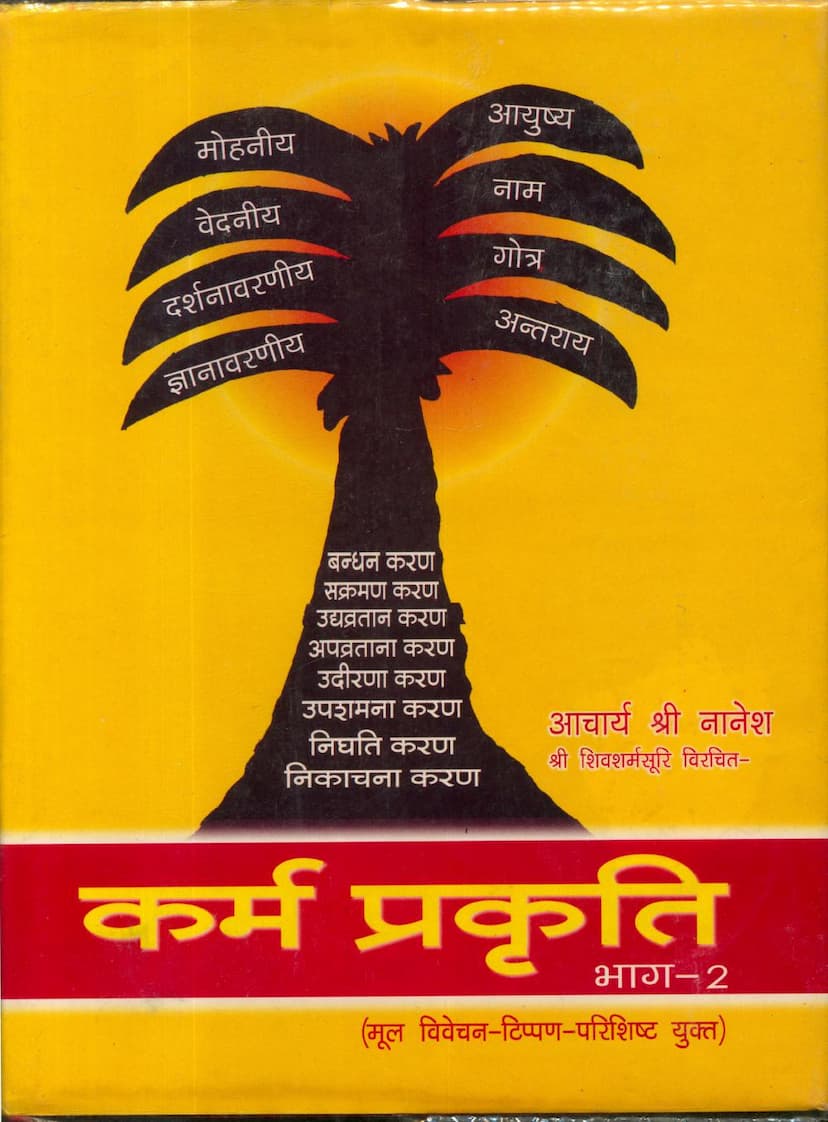Karm Prakruti Part 02
Added to library: September 2, 2025

Summary
Here's a comprehensive summary of "Karm Prakruti Part 02" in English, based on the provided text and catalog link:
Karm Prakruti Part 02 is the second volume of a Jain text, originally authored by Acharya Shriv Sharmsuri and further elucidated under the guidance of Acharya Nanesh. The compilation and editing were done by Devkumar Jain, and it was published by Ganesh Smruti Granthmala, an initiative of Shri Akhil Bharatiya Sadhuji Margiya Jain Sangh.
Core Subject Matter:
The book delves into the intricate details of the Jain concept of Karma. Building upon its predecessor (Part 01), this volume focuses on the Prakriti (nature) and Sankraman (transition/transference) of karmic particles, as well as other crucial karmic processes like Udirana, Upashamana, Nidhatti, Nikachana, Udaya, and Satta.
Key Themes and Concepts Covered:
The text provides a profound and detailed analysis of how karmic particles, which are believed to adhere to the soul, influence an individual's life. It explores:
-
Nature of Karma: It classifies the different types of karmas and their specific modes of operation. The initial pages outline the eight primary karmas:
- Darsanavaraniya (Perception-obscuring)
- Jnanaavarniya (Knowledge-obscuring)
- Mohaniya (Delusion-producing)
- Ayushya (Lifespan)
- Nama (Body-formation)
- Vedaniya (Feeling-producing)
- Gotra (Status/Lineage)
- Antaraya (Obstruction)
-
Karmic Processes (Karanas): The book systematically details the eight critical processes through which karma operates and can be modified or eliminated. The table of contents and specific sections elaborate on:
- Bandhan Karan: The process of bondage (attachment of karma).
- Sankraman Karan: The transition or transference of karmic particles from one state or nature to another. This is a major focus of Part 02. It discusses various types of sankraman, including prakriti sankraman, sthiti sankraman, anubhag sankraman, and pradesh sankraman. It also details the conditions under which these transitions occur, the timelines involved, and the types of souls and states of spiritual development that engage in them.
- Udirana Karan: The process of bringing forth or emitting karma to experience its effects prematurely.
- Upashamana Karan: The process of pacifying or suppressing the effects of karma through spiritual practices and austerities.
- Nidhatti Karan: A subtle form of karma that cannot be modified by subsequent actions (karma).
- Nikachana Karan: A severe form of karma that is absolutely unchangeable and must be experienced to its full extent.
- Udaya: The process of karma ripening and manifesting its effects.
- Satta: The state of karma being present in its latent form, ready to manifest.
-
Specific Karmic Interactions: The text meticulously describes how different karmas interact, influence each other, and transition between states. This includes detailed discussions on:
- The specific conditions and gunasthanas (stages of spiritual evolution) where sankraman occurs.
- The role of patadgraha (receptive states) and apatadgraha (non-receptive states) in sankraman.
- The saadi-anadi (beginning and timelessness) aspects of these karmic processes.
- Detailed analysis of mokshaniya (delusion-producing) karma's sankraman and udirana in relation to various spiritual stages.
- The nuances of sthiti sankraman (transition of duration), anubhag sankraman (transition of intensity/quality), and pradesh sankraman (transition of quantum).
-
Ownership (Swami): The text identifies the specific types of souls or spiritual stages that are responsible for or are the agents of these various karmic processes, particularly in their utkrushta (highest) and jaghanya (lowest) forms.
-
Detailed Analysis: The book is characterized by its thorough and systematic approach. It often breaks down complex concepts into minute details, classifying processes based on the number of karmic particles involved (prakriti), the duration (sthiti), the intensity (anubhag), and the quantum (pradesh).
Context and Purpose:
This work is intended for serious Jain scholars and practitioners interested in a deep understanding of the karmic science, which is fundamental to Jain philosophy and practice. The goal is to provide knowledge that can aid in the process of spiritual purification and eventual liberation (moksha) by understanding the mechanisms of karma and how to mitigate their effects or eliminate them entirely. The publisher's note emphasizes the Sangh's aim of personality development and societal progress through spiritual knowledge.
Key Figures:
- Acharya Shriv Sharmsuri: The original author, whose work forms the foundation of the text.
- Acharya Nanesh: Provided guidance and supervision for this volume, ensuring its authenticity and adherence to Jain principles.
- Devkumar Jain: The editor, responsible for compiling and presenting the detailed commentary and appendices.
Overall Significance:
"Karm Prakruti Part 02" is a highly technical and comprehensive manual on the mechanics of karma within the Jain tradition. It serves as a vital resource for those seeking to understand the complex interplay of karmic energies and their transformation, which is central to the path of liberation in Jainism. The detailed categorization of processes, transitions, and ownership across various spiritual states highlights the sophisticated nature of Jain ontology and soteriology.